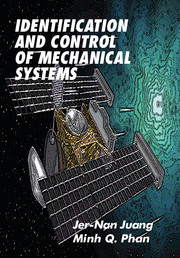Book contents
- Frontmatter
- Contents
- Preface
- 1 Ordinary Differential Equations
- 2 Elementary Matrix Algebra
- 3 Modeling Techniques
- 4 Finite-Element Method
- 5 Response of Dynamic Systems
- 6 Virtual Passive Controllers
- 7 State–Space Models
- 8 State-Feedback Control
- 9 Dynamic Feedback Controller
- 10 System Identification
- 11 Predictive Control
- Index
5 - Response of Dynamic Systems
Published online by Cambridge University Press: 02 September 2009
- Frontmatter
- Contents
- Preface
- 1 Ordinary Differential Equations
- 2 Elementary Matrix Algebra
- 3 Modeling Techniques
- 4 Finite-Element Method
- 5 Response of Dynamic Systems
- 6 Virtual Passive Controllers
- 7 State–Space Models
- 8 State-Feedback Control
- 9 Dynamic Feedback Controller
- 10 System Identification
- 11 Predictive Control
- Index
Summary
Introduction
In this chapter, the response of linear dynamic systems is studied in more detail. We begin with a study of efficient techniques for solving first-order and second-order single-degree-of-freedom (SDOF) equations of motion. Taking advantage of the simplicity of the first-order equation, we show how to obtain analytical expressions for the system response to harmonic excitation and how to write the steady-state response in terms of the magnitude and phase difference. It leads to the definition of the frequency-response function (FRF) and its analytical expression in terms of a complex variable (Ref. [1]). We then show how two- or more degree-of-freedom equations of motion can be treated similarly. The focus will be on multiple DOF mass–spring–damper systems (lumped parameter systems). The last part of this chapter deals with the bending vibration of flexible beams, which are described by partial differential equations rather than by ordinary differential equations for mass–spring–damper systems (Ref. [2]). The partial differential equations are decoupled by the separation of variable method to yield two sets of ordinary differential equations. From these equations, the common features of flexible structures are introduced, including the natural modes, frequency equations, and modal amplitudes. A discussion of the orthogonality property of the natural modes and the expansion theorem is then presented.
Single Degree of Freedom
A system of considerable importance in vibrations is the mass–spring–damper system, shown in Fig. 5.1.
Information
- Type
- Chapter
- Information
- Identification and Control of Mechanical Systems , pp. 120 - 144Publisher: Cambridge University PressPrint publication year: 2001
